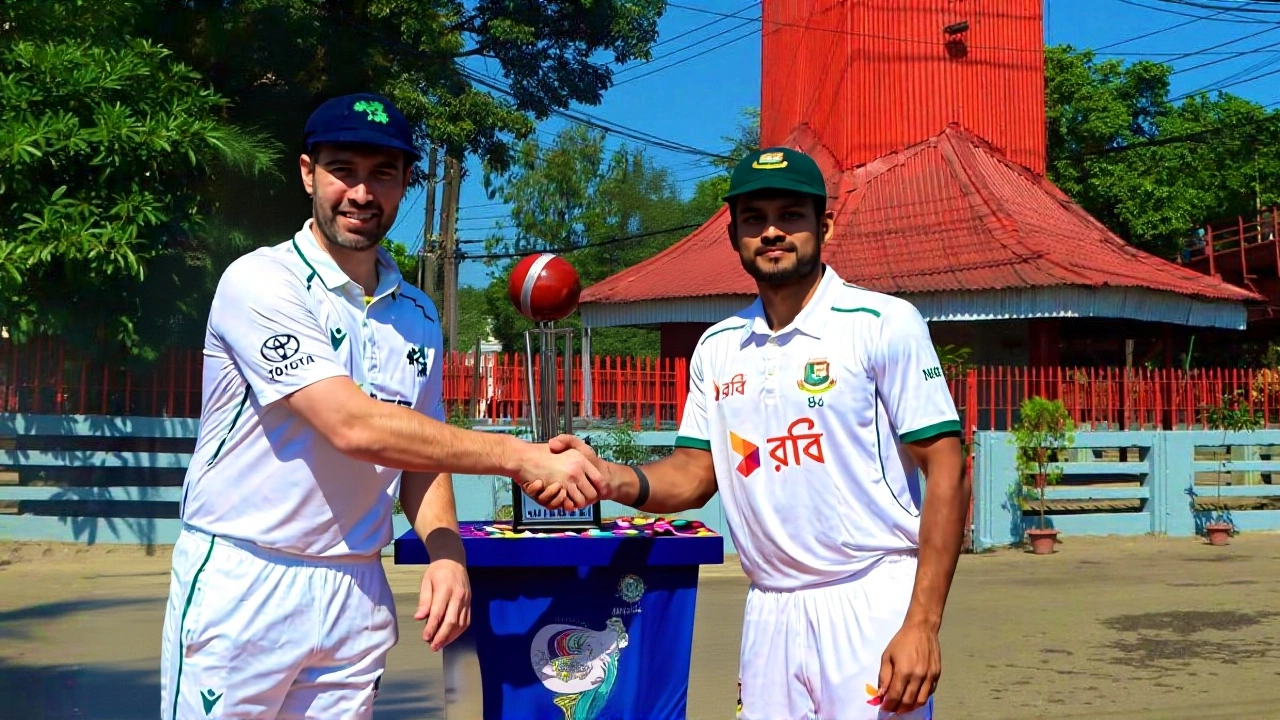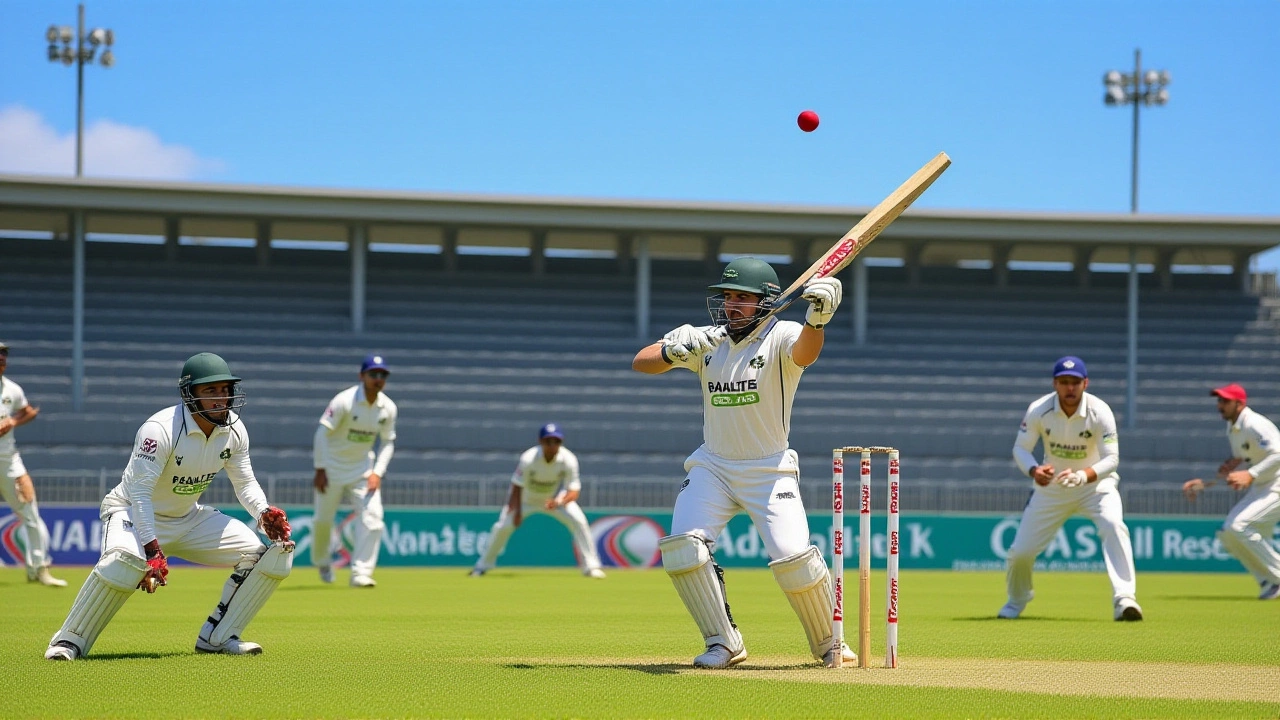When Mahmudul Hasan Joy stepped onto the crease on Day 2 of the first Test against Ireland at the Sylhet International Cricket Stadium, few expected he’d leave the field with a career-defining knock. But by stumps on November 12, 2025, Joy had carved out an unbeaten 169 off 283 balls — 16 boundaries strong — and handed Bangladesh a commanding 52-run lead with nine wickets intact. The hosts closed Day 2 at 338 for 1, their most dominant top-order performance in any format in recent memory. And while Joy missed out on his maiden double-century, his innings was the anchor that turned a competitive match into a one-sided affair.
Top-Order Dominance Silences Ireland’s Early Hope
After winning the toss and electing to bat first, Ireland scraped together 286, a respectable total on paper but one that looked fragile from the start. Paul Stirling’s 43 and Harry Tector’s 18 offered brief resistance, but the Irish top order collapsed under the spin guile of Taijul Islam (3/84) and Mehidy Hasan Miraz (4/48). By the 20th over of their second innings, Ireland were 51 for 5 — staring at an innings defeat before lunch.
Enter Lorcan Tucker, the 23-year-old debutant wicketkeeper-batter. What followed was a masterclass in grit. Tucker’s 108 off 149 balls — his first Test century — became only the sixth by a wicketkeeper on debut in Test history and only the second ever by an Irishman. He stitched together a 72-run stand with Tector and then a 111-run partnership with captain Andy McBrine. But it was too little, too late. Bangladesh’s lead, built on Joy’s monumental knock, was insurmountable.
Joy’s Masterclass: The Engine Behind the Victory
While Tucker’s century stole headlines, Joy’s innings was the quiet revolution. He batted for 6 hours and 28 minutes, absorbing pressure with a calmness rarely seen in a player with just five Test caps. His 16 boundaries came with surgical precision — no flashy pulls, no reckless drives. Just accumulation, patience, and power when the ball was in his zone. Opening partner Shadman Islam (80) and captain Mominul Haque (80*) provided vital support, but Joy was the architect.
"The Bangladesh Tigers programme helped me regain my form," Joy told reporters after play. "But I’m disappointed. I was within reach of a double-hundred. I could’ve been more ruthless in the final 30 overs." His self-criticism speaks volumes — this wasn’t just a good innings. It was a statement. He’s now the first Bangladeshi to score three Test centuries in a calendar year.
Historic Debutants and a Team in Transition
This match marked the Test debuts of three Irish players: Cade Carmichael, Jacob Neill, and Hasan Murad. For Ireland, it was a baptism by fire. Neill bowled 8 overs without a wicket, and Carmichael lasted just 8 balls before being bowled. Yet, the emergence of Tucker — who now joins the elite club of debutant century-makers — gives Ireland hope. His century was the first by an Irishman since Kevin O’Brien’s 110 against England in 2011.
For Bangladesh, the win extended their unbeaten home streak against associate nations to 12 matches. Their previous innings victory — by an innings and 109 runs over Zimbabwe in May 2024 at the same Sylhet venue — set a template. This one was even more decisive. By the end of play on November 14, 2025, Bangladesh had won by an innings and 47 runs, sealing the match with 12 overs to spare.

What’s Next? Rahim’s Century and the Road to 2027
The second Test of the Dutch-Bangla Bank Bangladesh Ireland Test Series 2025 begins November 19, 2025, at the Shere Bangla National Stadium in Dhaka. The big story? Mushfiqur Rahim will play his 100th Test match — becoming only the third Bangladeshi to reach the milestone after Shakib Al Hasan and Tamim Iqbal.
This series isn’t just about pride. Both teams are building toward the 2027 ICC Cricket World Cup qualification pathway. For Bangladesh, it’s about maintaining momentum. For Ireland, it’s about proving they can compete beyond one brilliant innings. Tucker’s century may be the spark, but Joy’s 169* was the fire that lit the entire stadium.
Frequently Asked Questions
How significant is Mahmudul Hasan Joy’s 169* in Bangladesh’s Test history?
Joy’s 169* is the highest individual score by a Bangladeshi batter in a home Test against an associate nation since 2018. It’s also his third century of 2025, making him the first Bangladeshi to achieve that in a single calendar year. Only Shakib Al Hasan and Tamim Iqbal have scored more Test centuries for Bangladesh overall.
Why was Ireland’s second innings collapse so dramatic?
Bangladesh’s spin duo — Taijul Islam and Mehidy Hasan Miraz — exploited the worn pitch after Joy’s long innings. Ireland’s middle order, lacking experience, couldn’t handle the turn and bounce. After losing five wickets for just 51 runs, their batting depth was exposed. Tucker’s century was heroic, but it came too late to change the match’s trajectory.
What does Lorcan Tucker’s century mean for Irish cricket?
Tucker’s 108 is only the second Test century by an Irishman and the sixth by a wicketkeeper on debut in history. It’s a landmark moment for a team that’s struggled to produce consistent top-order batters. His performance gives Ireland’s selectors confidence to build around him, especially as they aim to qualify for the 2027 World Cup.
How does this result affect Bangladesh’s World Cup qualification chances?
Bangladesh’s dominant win boosts their ICC Test rankings and reinforces their status as a strong home side. With a 12-match unbeaten streak against associate nations, they’re building momentum ahead of the 2027 World Cup qualifiers. Their next series against Sri Lanka in March 2026 will be critical for maintaining Test status and securing direct entry into the next World Cup cycle.
Is Mushfiqur Rahim’s 100th Test a record for Bangladesh?
No, but it’s rare. Only Shakib Al Hasan (100+ Tests) and Tamim Iqbal (97 as of late 2025) have played more. Rahim will become the third Bangladeshi to reach the milestone, joining an elite group. His experience will be vital in mentoring younger players like Joy and Islam as Bangladesh transitions into a new era post-2027.
What role did the pitch at Sylhet play in the match outcome?
The Sylhet pitch offered consistent turn and variable bounce from Day 2 onward, favoring spinners as the game progressed. Bangladesh’s top order capitalized on the early flat conditions, while Ireland’s batsmen struggled to adjust to the increasing grip. By Day 4, the pitch had cracked and slowed, making strokeplay difficult — a key reason Ireland’s second innings collapsed.

